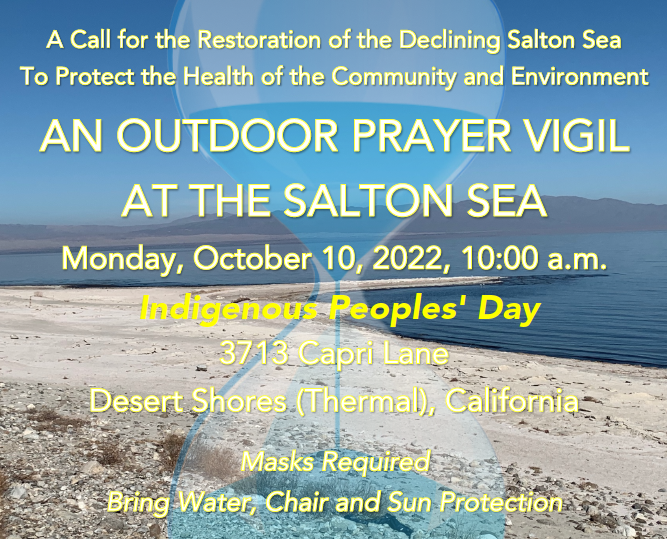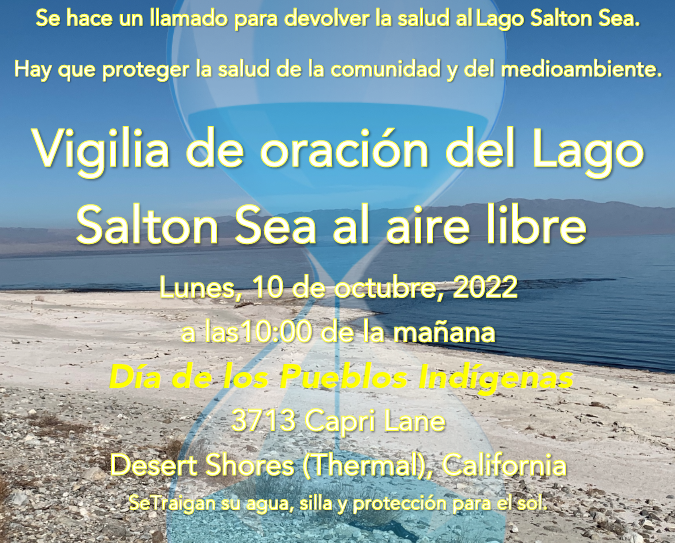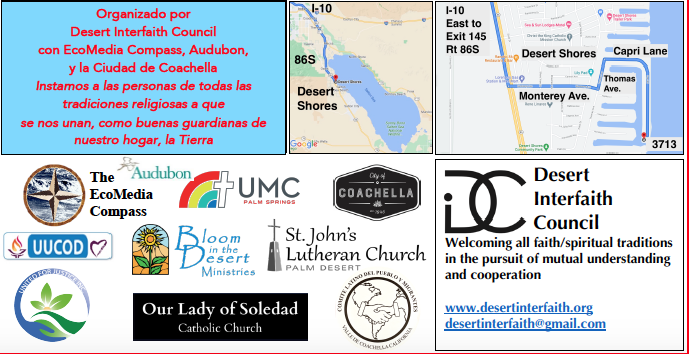Prayers and Calls for Action at the Salton Sea
An Indigenous Peoples’ Day Vigil, Oct 10, 2022 at Desert Shores
Dispatch from the Heart of an Environmental and Social Justice Apocalypse
by Ruth Nolan, Mojave Desert Literary Laureate, October 20, 2022
Not far from the iconic and uber-popular Joshua Tree National Park and even fewer miles from the world’s most fabled music festival, Coachella, a glaringly overshadowed dark side to the love affair with the desert: the Salton Sea. It hovers surrealistically below sea level in a huge basin in the middle of one of the hottest deserts in the world, in a neglected and little-known corner of southern California that borders Mexico, its waters shrinking daily at an alarming rate.
It is an historic body of water, layered over the Ancient Lake Cahuilla known long to the region’s Cahuilla, Kumeyaay, Quechan and other indigenous people who have lived in complex ecologic relationships with its cyclical presence and disappearance over time immemorial, its waters filling the basin then receding over long periods of time as Colorado River and Gulf of California-Sea of Cortez waters flowed into the basin – or didn’t.
Today, the Salton Sea and the rural communities that line its rapidly receding shoreline lie within the unfortunate crosshairs of a decades-long, ugly political battle that reflect the classic tug of wars of resource allotments in the Western U.S between powerful water agencies; a complex of agencies and groups who have land holdings and interests in the Sea’s waters and land base; and the State of California’s lack of action on leading the Sea’s restoration – something it promised to do as far back as 2003 but so far has failed to accomplish.
It is a place where just a few years ago, huge populations of American White Pelicans and Eared Grebes wintered, feeding on fish in the bountiful Sea, these populations have been reduced more than 95% since 2017, according to the Audubon Society, as water transfers for the Sea’s only inflow – previously coming from several rivers in Imperial County, via the Colorado River - began in 2003, and escalated with Imperial Irrigation District’s larger-scale water transfer initiated in 2017, drastically shrinking the size of the Salton Sea.
It is a place where residents in low-income communities – many comprised primarily of people of color – are experiencing high levels of respiratory illnesses as exposed playa dust fill the air during the days and nights when the wind blows. Which it does frequently. In fact, also according to the Audubon Society, 12,000 children in Imperial County, who live in the Sea’s vicinity, currently experience chronic lung disease.
It is an historic and beloved place of life, this place known as the Salton Sea, long cherished for its abundance of food and sustenance resources, its exotic beauty, its sparkling blue waters and colorful vacation and recreational activities.
It is a place being ravaged for these very waters. A place being broken down day by day by broken promises from elected officials, multinational corporations who are now laying down plans to break the Sea’s very soul with large-scale lithium mining, a place being pilfered for every drop of water going to fill swimming pools and water lawns in coastal cities, and for what is being called the early 21st century’s “white gold” rush.
It is a place that needs love, and attention, and gratitude, to know that it is still valued and honored and thanked for its place in a harsh desert that has always offered the gift of life. It is a place where calls for human and social, as well as environmental and ecologic justice, emanate deep from some peoples’ souls.
And so, on Indigenous People’s Day this October, a gathering of religious and spiritual leaders led by the Desert Interfaith Council tribal members, community activists, and concerned citizens converged at a place that not long ago was at water’s edge in the decrepit town of Desert Shores for a prayer vigil and call to action.
There were members of the Salton Sea Coalition, a local grassroots group that is advocating tirelessly for the adaptation of a sea water importation plan to restore the Salton Sea. There were members of the Torres Martinez Cahuilla Indian tribe, whose land base surrounds and in places underlies the northern parts of the Sea. There were several internationally recognized activists from Mexico, singing and speaking out for justice, and there were leaders from the Audubon Society and City of Coachella.
There were religious and spiritual leaders from the Coachella Valley. There was a professor from College of the Desert. The mayor of Calexico, a town situated at the U.S./Mexico border not far to the south, spoke. There was a group of Latinx women who live in Desert Shores, speaking of their children’s battles with asthma and trips to the emergency room, fighting to stay healthy in this place, where the toxic air quality literally threatens their lives.
There was heart-wrenching guitar playing and singing by decades-long Chicanx activist Rosa Martha Zárate Macías, whose voice lifted a community call for action. Her ballad echoed the voices of so many activists who have come before and rally to this day, calling for equity and justice.
“People of faith can no longer sit silently as the Salton Sea continues to deteriorate and action is placed only in the hands of politicians and environmental activists,” said Paula Trimble-Familetti, Desert Interfaith Council President and organizer of this event. This is a profound moral issue, and we are asking all people to step up as stewards of our earth and accept a personal responsibility to care for God’s creation.”
And this gathering for resistance and prayer and calls for action took place just days after an historically large haboob – a massive desert dust storm connected to monsoonal weather – slammed its way across the entirety of Imperial County and the Coachella Valley to the west, crossing over the Salton Sea play, picking up more toxic dust there to add to the mix. The air quality in these areas was so bad during, and for more than 24 hours afterwards that South Coast Air Quality Management advised people to stay indoors to avoid breathing dangerous PM10 particles that still hovered in the air.
In 2017, there were 18,600 acres of exposed playa dust from the receding Salton Sea, compared to 862 acres in 2003. Without mitigation to current water transfers, there will be an estimated 67,000 acres of exposed playa dust here. All of this, also according to Audubon Society statistics.
And all of this, a vigil of prayer and calls for action, just days after the unfortunate news that the state appointed UCSC panel rejected proposed plans for importing sea water that were hoped to be a key part of restoring the Salton Sea.
Among the “glaring flaws” of UCSC review process are apparent, according to Salton Sea Coalition co-chairs Chuck Parker and Felicitas Nunez: “The UCSC panel ruled out water import from the Sea of Cortez without ever contacting water agencies in Mexico to sound out their willingness to discuss the possibility; they suppressed the benefits for Mexico that were written into most of the submitted proposals that included water from the Sea of Cortez, including financial incentives, energy generation, and increased water supply and more long term good paying jobs; and they inflated costs of water transportation by choosing dual pipelines instead of canals.”
And this, according to the Salton Sea Coalition, despite that “in the face of overwhelming local support for ocean water importation to refill the Salton Sea and cover the playa, the state of California published a request for proposals for water importation plans. Eleven proposals were submitted, but none were fully reviewed. This, despite that in 2019, the 9 city councils of the Coachella Valley, the Torres Martinez Band of Cahuilla Indians, and the Board of Trustees of the College of the Desert all passed resolutions in favor of "a comprehensive review of ocean water import."
Where do we go from here? The prayers and songs and voices have been offered, followed by another massive dust storm across the Imperial and Coachella Valleys just days later – similarly to the earlier haboob, but this time, bringing the relief and cleansing of heavy rains, which helped with air quality.
The Salton Sea Coalition recommends that “The pressure on politicians is necessary because they are servants of the people who got them elected.” Key among the Coalition’s immediate requests to Governor Gavin Newsom for Salton Sea restoration are as follows:
1. Address CA drought.
2. Import water from the Pacific Ocean or El Mar de Cortez.
3. Provide potable water.
4. Address health issues.
5. Fill up the Salton Sea with imported water.
6. Clean the pollution.
And so, the voices and songs will continue to fill the air at Desert Shores, in prayer and word, alongside the cries of the very few migratory birds arriving this year to winter in their ancestral flyway grounds in their north to south migrations. May their cries, and ours, echo louder now as they cascade and mirror back across a rapidly emptying void of a sun-baked playa that just a few years ago held water and sustained so much life, and, in an increasingly desperate cacophony, be heard through the blinding dust.




HOME.....Mojave Literary Laureate Writings
